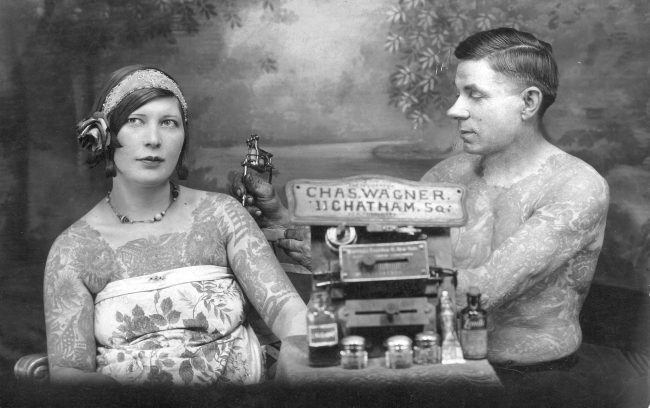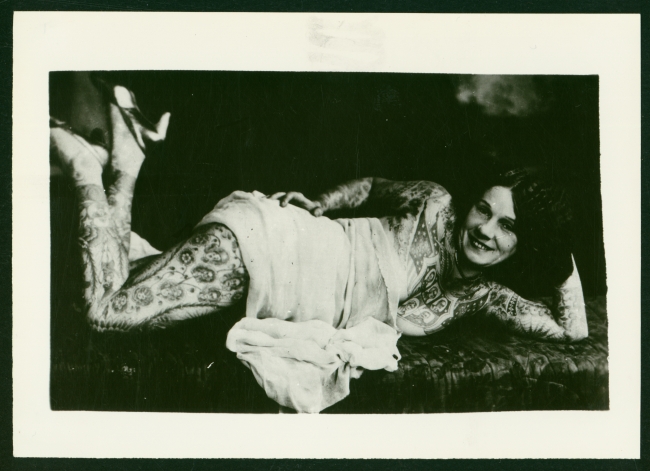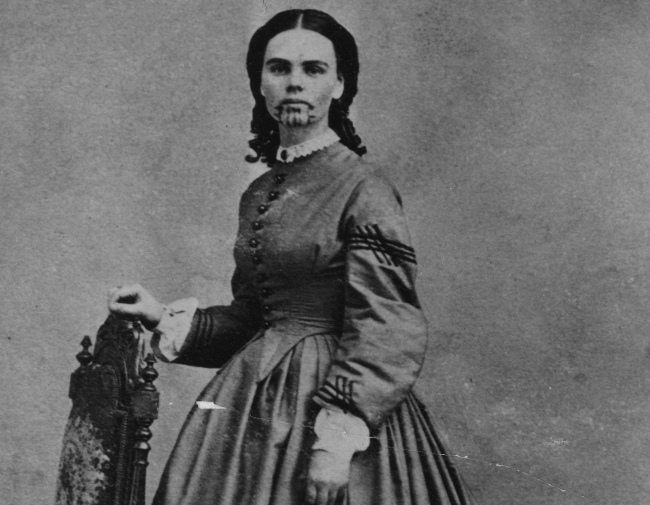When Did Female Tattoos Get Popular
The Colorful, Subversive History of Women Getting Tattoos
A recently reissued volume traces how body fine art went from forbidden to trendy.

powerHouse Books
Tattooed ladies were one time carnival freaks. Now they're cool hipster chicks. A recently published third edition of a volume about body art, Bodies of Subversion: A Secret History of Women and the Tattoo past Margot Mifflin (powerHouse Books), traces that shift, documenting how tattoos' popularity has risen amid women as the social implications of getting them have shifted. It'due south a adept time for a tome similar this: Mifflin told me that tattooing has inverse tremendously in the couple of past decades, both aesthetically—improved color and more detailed, expansive imagery—and socially, to the indicate where it has "fully entered the eye course." She added that "as of last year, for the first time in American history, more than women are tattooed than men."
Mifflin, who is non tattooed, is an Acquaintance Professor at Lehman Higher/CUNY Graduate School of Journalism and came to tattooing as a cultural critic in the mid '90s after writing about feminist fine art and pop culture for publications like Elle and ARTnews: "I saw that tattooing was an amazing barometer of women's dreams and fears and passions at that time—a menses when trunk issues were at a height of controversy at the end of the civilisation wars—and it made me wonder what women's tattoos revealed virtually them going back to the 19th century when European and American women started getting inked."

Although much has already been written about tattooing, peculiarly in the terminal decade, Mifflin notes that very footling of what'southward in the popular press is critical or analytical: "I take e'er been and proceed to be amazed at how little interest visually literate people have in tattooing, which is all effectually us." Only in the by couple of decades has what she calls a "chronic class bias in the visual arts" turned around somewhat. Now, "depression" arts like graffiti are now themes for scholarship. Fifty-fifty so, while mass media is enthusiastic virtually tattoos, the fine art world still shows petty interest in them, despite their links to popular fashion, folk fine art, graphic pattern, and fine fine art.
So Mifflin's thesis is rooted in subversion. She asserts that tattoos in Western civilization take e'er been subversive for women, especially in the 19th century when they violated the assumption that "women should be pure, that their bodies should be concealed and controlled, and that ladies should non express their own desires, which is implicit in the very act of permanently marking the peel with imagery that reflects individual tastes." In the early on 20th century, tattoos were stigmatized (fifty-fifty illegal in some jurisdictions) because of their association with raunchy male imagery. Middle-form women who were tattooed knew they would be considered "loose" or seedy if they showed their marks. Past the '60s and '70s, tattooing became more directly linked to the counterculture, and remained and so until the 2000s. Now tattoos are not as subversive or associated with "bad" women—instead, they have get fashion accessories of the most indelible kind.
Although "not all tattooed women were considered freaks—tattooed club women wore discreet decorative tattoos, which were trendy in the late 19th century, first in London, then in New York," heavily inked women were considered "a violation of nature." Something similar could be said for men, but women were decidedly less accepted because "they were more explicitly associated with nature through motherhood and female intuition and other feminine intangibles that disqualified them from having much influence in civilization." The circus and carnival freak-prove ladies were too guilty of transgression considering they showed bare skin in public.
Mifflin refers in her book to Olive Oatman, "a tragically bicultural American" who was orphaned after her family unit was killed by Southwest Indians in the 1850s, then adopted and raised by Mohave Indians who gave her a chin tattoo as a marker of tribal acceptance. After she was ransomed dorsum to the whites at age 19, she was stranded between the two cultures and the tattoo marked her as a Mohave and functioned every bit a kind of ethnic bulwark. "It's somehow fitting," Mifflin said, "In light of our colonial by and our multicultural present, that the beginning American tattooed woman was a white Indian. She literally embodied the 2 cultures on which the country was founded."

The permanency of tattoos is the most confounding, and controversial, issue across genders. Nosotros all switch pictures on the wall from time to time or change our jewelry, simply those who wear conspicuously outrageous tattoos are doing it for life. Mifflin said that although the people she has talked with seem to exist content, "yous do take to wonder if someone would tell y'all that they made a huge fault they regret and volition have to prove publicly forever. I have only heard about regrets about mistakes that can be subconscious."
When Did Female Tattoos Get Popular,
Source: https://www.theatlantic.com/sexes/archive/2013/04/the-colorful-subversive-history-of-women-getting-tattoos/274658/
Posted by: alvaradomighose.blogspot.com


0 Response to "When Did Female Tattoos Get Popular"
Post a Comment